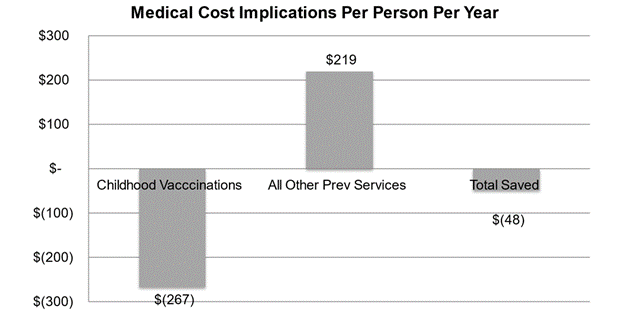The fallacy of future cost savings
July 26, 2024
Source: Maciosek, M Health Affairs, 2010 LINK
I’m often asked, “If we increase the rate of preventive care among our employees, how much money will we save?” If only things were so simple!
Most preventive health care does NOT lower medical claims costs now or in the future. Rather, good preventive care gives people better and longer lives.
In this way, preventive care is much like the rest of medical care. We don’t save current or future medical expenses by treating someone’s cancer or heart disease. Rather, we make them live longer and better lives. As patients have better health, they are more productive and likely to stay in the workforce. As they live longer, they go on to have other expensive illnesses too!
There are a handful of preventive services that are cost SAVING. That means for each dollar spent, more than a dollar is saved. These are:
● Childhood vaccinations
● Birth control
Childhood vaccinations are recommended by the Advisory Committee on Immunization Practices (ACIP) and contraceptives are recommended by the Health Resource Services Administration (HRSA), so both are offered to patients without cost sharing, as required by the Affordable Care Act (ACA).
There are some other preventive services that each save a small amount of money after accounting for their costs, but in an employer’s medical budget these are not much more than a rounding error. This includes cigarette cessation programs, alcohol counseling, palliative care at the end of life, and flu shots over age 55.
Most preventive care is cost-EFFECTIVE. That means that each additional quality adjusted life year (QALY) costs a reasonable, and not excessive, amount. For instance, mammography costs about $50,000 per QALY. This means that when higher portion of women get mammograms as recommended there are fewer deaths from breast cancer, but medical costs are higher, not lower. Most health policymakers think that medical care that costs under $100,000 (or $150,000) per QALY should be covered in the United States.
Some preventive care, such as annual physical exams for young healthy people, have not been shown to have any clinical benefit over populations, so it’s impossible to calculate whether they are cost effective. Even so, annual wellness exams must be covered without cost sharing based on current interpretation of the Affordable Care Act. I discourage employers from offering incentives to encourage their members to get annual exams.
The total medical claims cost savings from childhood vaccinations are MORE than the total medical claims cost savings for ALL preventive services (since most of them increase total medical expenditures).
I think of this as the “fallacy of future cost savings.” It makes intuitive sense that finding breast cancers earlier would save money, since a lumpectomy surely costs less than treatment for metastatic cancer. But providers must perform a lot of mammograms, ultrasounds, and biopsies for each breast cancer found early. Further, some cancers have already spread when found through screening, and early detection doesn’t improve health or save money. Increased screening also might find some cancers that would never hurt people (overdiagnosis).
Implications for employers:
Exercise caution when interpreting future medical cost savings claims.
Employers should strongly encourage preventive care, although they should not expect this to lower total medical expenditures.
Employers should communicate to their members that certain preventive care services that are cost-saving, pediatric vaccines and birth control, are available without cost sharing.
Employers can instruct their pharmacy benefit managers to provide birth control without cost sharing even if purchased from local pharmacies (i.e take off penalties for not using mail order).
Employers can request reporting on childhood vaccinations from their carriers.
Thanks for reading. You can find previous posts in the Employer Coverage archive
Please subscribe, “like” and suggest this newsletter to friends and colleagues. Thanks!
Monday: We are falling behind on pediatric vaccinations

